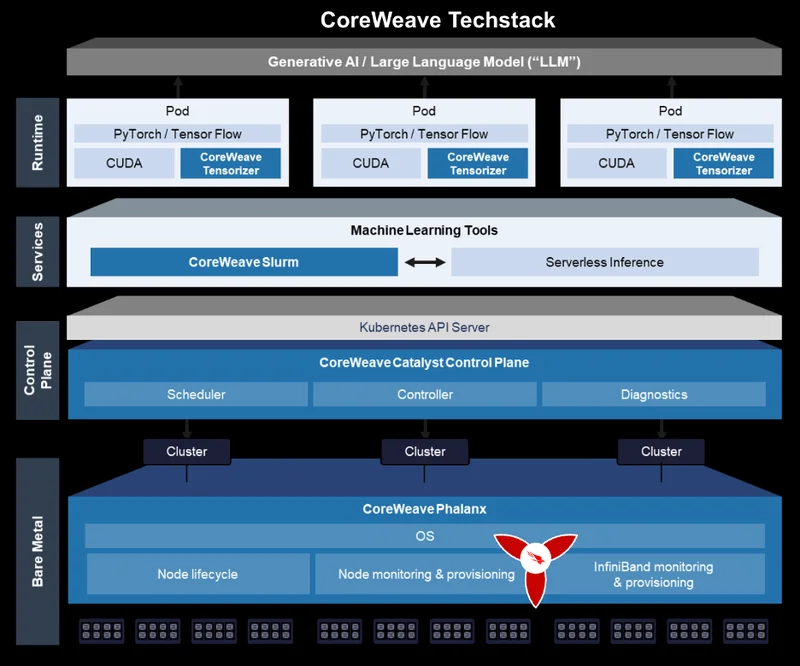XLM Insight | Stellar Lumens News, Price Trends & Guides
XLM Insight | Stellar Lumens News, Price Trends & Guides
The rumble you hear isn't distant thunder; it's the foundational tremors of an entirely new era, one being built, brick by digital brick, in places like a colossal data center in Plano, Texas. Imagine a sprawling 450,000 square feet, humming with 30 megawatts of raw computing power, a monument to the insatiable hunger of AI. This isn't just a building; it's a crucible where the future is forged, a physical manifestation of the boundless ambition driving the AI revolution. And at its heart? A company called CoreWeave, whose story isn't just about its balance sheet, but about the audacious, exhilarating gamble we're all making on tomorrow.
Now, I know what some of you are thinking. You've heard the whispers, seen the headlines: "AI bubble," "debt mountain," "financial meltdown." A recent article highlights these concerns, titled As data-center operator CoreWeave prepares for earnings, stock bears worry its finances are emblematic of an AI bubble. And yes, if you squint at the numbers in isolation, CoreWeave’s financial structure looks… well, bold. With $7.6 billion in current liabilities and $11 billion in total debt, against revenues of $1.9 billion in 2024, it’s certainly a tightrope walk. But let's zoom out for a moment, shall we? This isn't a quaint startup selling artisanal candles; this is a company building the very infrastructure that Microsoft, OpenAI, and Meta need to deliver on the promise of AI. They’re not just spending money; they’re investing in the digital bedrock of our collective future, and that, my friends, is a fundamentally different equation.
What we're witnessing with CoreWeave isn't just a business strategy; it’s an echo of every great infrastructure buildout in history. Think of the transcontinental railroad – a massive, debt-fueled undertaking that looked insane on paper until it unlocked an entire continent. Or the early days of the internet, when companies poured billions into fiber optics and server farms, often bleeding cash for years before the tidal wave of adoption hit. This is that moment for AI. CoreWeave’s $34 billion in scheduled lease payments, much of it for facilities not yet generating revenue, isn’t merely a liability; it’s a pre-emptive strike, a bet that the demand will not just materialize, but will explode. When I first saw the scale of these commitments, I honestly just sat back in my chair, speechless, trying to grasp the sheer, audacious scale of their vision. It's truly inspiring.

Skeptics, like Gil Luria from D.A. Davidson, look at the numbers and see a path to bankruptcy, questioning if CoreWeave can "scale out of this." And yes, if you project current razor-thin 1.6% operating margins indefinitely, it’s a tough sell. But that’s like judging a nascent sapling by its first few leaves, ignoring the forest it’s destined to become. The real story lies in what’s not on the balance sheet: the "remaining performance obligations," or RPOs. These aren't just theoretical bookings; these are massive, long-term contracts for future computing capacity, like the $14.2 billion deal with Meta or the pact with Poolside for 40,000 Nvidia GPUs. These are the future revenues, the fuel for the engine, that will eventually dwarf today’s capital expenditures. It’s an investment in tomorrow’s certainty, a certainty fueled by the undeniable trajectory of AI.
The sheer velocity of demand for AI compute power is staggering—it means the gap between today and tomorrow is closing faster than we can even comprehend, and companies like CoreWeave are racing to fill that void. They're essentially the "picks and shovels" of this new gold rush, providing the raw compute power that everyone from Microsoft to OpenAI desperately needs. And while some worry about customer concentration – indeed, 71% of Q2 2025 revenue came from Microsoft alone – we also see diversification with Meta and other players. Is it risky? Absolutely. Is it necessary? Undeniably. Every paradigm shift, every technological leap forward, has required this kind of upfront, speculative investment. What ethical considerations does this massive build-out bring? We need to ensure that as we construct these digital cathedrals, we're also building in accessibility, sustainability, and robust security. The power concentrated in these data centers demands a commensurate level of responsibility.
Thomas Blakey, a managing director at Cantor Fitzgerald, puts it perfectly: "A lot has to go right." He compares this moment to the early days of the smartphone, when analysts doubted Apple’s transformative claims. He's right. It will be perilous. But the opportunity? "The potential is beyond the scope of our imagination at this point," as Kevin Dede of H.C. Wainwright so eloquently stated. The renegotiation of DDTL 2.0 loan terms to delay principal payments isn't a sign of weakness; it's a testament to creditors' belief in the long-term vision, a willingness to bet on the future. CoreWeave is a leader in a market where demand far exceeds capacity, and that, my friends, is a powerful position to be in.
So, what does this all boil down to? CoreWeave isn't just a company; it's a living, breathing case study in the monumental, often messy, but absolutely essential process of building the infrastructure for a truly transformative technology. The "debt mountain" isn't a sign of impending doom; it’s the cost of admission to a future we're all hurtling towards. It’s the concrete, steel, and silicon embodiment of our collective ambition. The financial reports we scrutinize on Monday are just snapshots on a much longer journey. The real story is the relentless march of AI, and companies like CoreWeave are the unsung heroes laying down the tracks for that journey, one massive data center at a time. This isn't a bubble; it's the foundation of a new world, and it's being built right now, right before our very eyes.